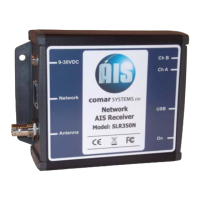
Do you have a question about the Comar Systems SLR-350N and is the answer not in the manual?
| Channels | 2 |
|---|---|
| Output | NMEA 0183 |
| Frequency Range | 156.025 MHz to 162.025 MHz |
| Sensitivity | -107dBm |
| Modulation | GMSK |
| Input Impedance | 50 Ohms |
| Weight | 250 g |
| Frequency | 162.025 MHz |
| Power Supply | 12V DC |
Details the warranty period, terms, and conditions for product defects in materials and manufacture.
Explains the Automatic Identification System (AIS) and its purpose for safety and collision avoidance.
Describes the SLR-350N as an AIS receiver unit with Ethernet and USB interfaces for coastal monitoring.
Provides guidance on mounting the receiver unit to a suitable surface, avoiding heat and shock.
Instructions on connecting the unit to a power supply, including voltage and polarity details.
Details on connecting a VHF antenna, noting it is not supplied and requirements vary by installation.
Explains how to connect the SLR350N to a PC via USB for local monitoring using provided software.
Describes connecting the SLR350N to a PC, network router, or switch via Ethernet for data transmission.
Details the expected indicator light behavior upon powering up the SLR-350N unit.
Troubleshooting steps for when the unit's power indicator light is not illuminated.
Steps to resolve issues where the channel indicator lights are not flashing as expected.
Guidance on disabling software and physical firewalls that may block the discovery process.
Instructions for disabling the Windows Firewall on XP to allow the discovery software to function.
Advice on dealing with routers or switches that may block discovery traffic, suggesting hubs or direct connections.
Suggests trying a direct crossover Ethernet cable or another Ethernet cable to resolve connectivity problems.
Instructs to check the Ethernet Link LED for a solid light, indicating a valid network connection.
Ensures the correct network adapter is enabled and others are disabled to prevent discovery process failure.
Using Device Discovery to configure network settings, allowing Windows to assign an IP or setting a fixed IP.
Accessing the unit's internal web interface via a browser for configuration and management.
Navigating directly to the unit's assigned IP address using a preferred web browser for configuration.